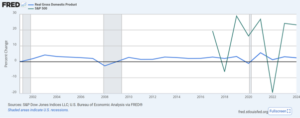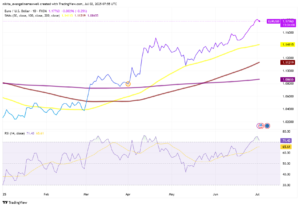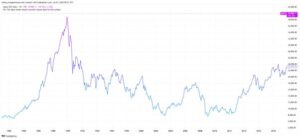Background Analysis
The Federal Reserve announced a 25-basis-point rate cut during its December 2024 meeting, marking the third consecutive reduction. This brings the federal funds rate to a target range of 4.25%-4.5%, a level last seen in December 2022. While the decision was widely anticipated, the cautious tone about the future pace of rate cuts grabbed market attention.
The Fed faces a challenging environment where inflation remains above target, and economic growth continues to be robust, conditions typically warranting tighter monetary policy. However, the central bank has opted to ease, highlighting the complexity of its current balancing act.
Rate Cut Decision and Market Reaction
The Rate Cut and Its Implications
This latest reduction brings the Fed’s cumulative cuts to 1 percentage point since September 2024. Chair Jerome Powell emphasized that the Fed's stance is now “less restrictive” and provides room for careful evaluation of future adjustments. He noted, “We can therefore be more cautious as we consider further adjustments to our policy rate.”
Market Response
The rate cut triggered significant market reactions:
- Stock markets tumbled, with the Dow Jones Industrial Average dropping over 1,100 points.
- Treasury yields surged, with the 2-year yield climbing to 4.3%, surpassing the Fed's upper target range.
- Expectations for additional rate cuts in 2025 diminished sharply, according to the CME Group’s FedWatch tool.
Dissent Within the FOMC
Cleveland Fed President Beth Hammack dissented, advocating for holding rates steady. This marks the second consecutive meeting with dissenting votes, indicating diverging views within the Federal Open Market Committee (FOMC).
Future Policy Path
Updated Dot Plot Projections
The Fed’s updated “dot plot” revealed a notable shift in future rate expectations:
- 2025 Rate Cuts: Reduced from four to two cuts, reflecting greater caution about the pace of easing.
- 2026 and Beyond: Two more cuts projected in 2026 and an additional cut in 2027.
- Long-term Neutral Rate: Adjusted upward to 3%, signaling a gradual recalibration of the Fed’s policy framework.
Economic Outlook
Despite the rate cuts, the Fed revised its economic projections:
- GDP Growth: 2024 growth expectations were raised to 2.5%, up from 2% in September, though it is expected to slow to 1.8% in the longer term.
- Unemployment: The unemployment rate forecast for 2024 was lowered to 4.2%.
- Inflation: Core inflation expectations were revised upward to 2.8%, well above the Fed’s 2% target.
Powell highlighted that while the economy is performing strongly, maintaining overly restrictive rates could unnecessarily slow growth.
Factors Influencing the Fed’s Approach
-
Persistent Inflation
Core inflation has remained stubborn, increasing 3.3% year-over-year for the fourth consecutive month. Sticky inflation complicates the Fed's ability to justify aggressive rate cuts. -
Strong Economic Performance
The Atlanta Fed estimates that U.S. GDP grew at a 3.2% annualized rate in the fourth quarter of 2024, supported by a resilient labor market. -
Fiscal Policy Uncertainty
President-elect Donald Trump’s proposed policies, including tariffs, tax cuts, and immigration measures, could introduce inflationary pressures and further complicate the Fed’s policy decisions.
Powell acknowledged the uncertainty surrounding fiscal policy, noting, “We need to take our time, not rush, and make a very careful assessment once we see how these policies are implemented.”
Implications for Markets
-
Dollar Strength
A slower pace of rate cuts could support the U.S. dollar, particularly against currencies from economies adopting more accommodative monetary policies. -
Global Interest Rate Dynamics
Changes in the Fed’s approach may influence global capital flows, impacting emerging markets and other economies sensitive to U.S. monetary policy. -
Investor Strategies
Investors may need to adjust their portfolios to reflect the Fed’s cautious stance, with potential impacts on bond yields, equities, and forex markets.
Looking Ahead
The Fed’s December 2024 decision highlights a strategic shift toward a more cautious approach in managing its monetary policy. With inflation proving sticky and the economy showing resilience, the Fed has adopted a more measured stance, signaling fewer rate cuts in the years ahead.
For forex traders and investors, understanding these policy adjustments and their implications is critical for navigating potential market volatility. The coming months will hinge on inflation trends, fiscal developments, and the Fed’s evolving perspective on economic conditions.
Conclusion
The Federal Reserve’s cautious tone on future rate cuts underscores the delicate balance it seeks to strike between supporting economic growth and managing inflation risks. As monetary policy enters a recalibration phase, global markets must remain vigilant to potential shifts in the Fed’s strategy.
Key Takeaway: The Fed’s latest move reflects its commitment to a gradual, data-driven approach as it seeks to navigate a complex economic landscape. Investors should stay attuned to key economic indicators and policy signals to align with the evolving environment.





